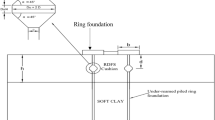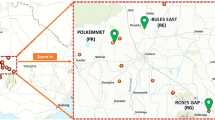Abstract
Stabilizing the base layers of flexible pavements is gaining tremendous attention due to the lack of suitable construction materials. A geogrid reinforcement could offer a reduction in granular layer thickness or enhance the service life of the pavement. However, there is no standard direct methodology available for the design of a flexible pavement with a geogrid-reinforced base layer. The current design approaches adopt the base layer coefficient ratio (LCR) derived from the layer coefficient equation proposed by the American Association of State Highway and Transportation Officials (AASHTO 1993), which was initially developed for an unreinforced base layer. Moreover, the accuracy of the existing model for determining the base layer coefficient needs a reassessment since it varies for different subgrade conditions. Hence, an attempt was made to propose a new model which emphasizes on unreinforced and geogrid-reinforced base layer coefficients for weak-to-moderate subgrade conditions. Prior to the analysis, large-scale model pavement experiments were conducted to realize modulus improvement factor (MIF) and range of values of LCR of different geogrids, which are crucial parameters used in the design. In addition, design examples, validation and the MIF and LCR values of geogrid-reinforced base layer were provided for obtaining the base layer coefficients. It was noticed that the MIF and LCR value for the geogrid-reinforced base layers range between 1.6–3.33 and 1.23–1.59, respectively. The newly proposed equation for the base layer coefficients accounted for about a 33% reduction in the base layer thickness compared to the unreinforced case. Hence, a safe and economical pavement section may be obtained from the proposed model.













Similar content being viewed by others
Abbreviations
- a :
-
Radius of circular loading plate
- a 1, a 2 :
-
Layer coefficients of asphalt and base layers
- a 2r :
-
Base layer coefficient of reinforced section
- a 2u :
-
Base layer coefficient of unreinforced section
- d 1, d 2 :
-
Asphalt and base layer thicknesses
- d 2r :
-
Reinforced base layer thickness
- D :
-
Diameter of circular plate
- E 1 :
-
Elastic modulus of layer 1 (base and subbase together)
- E 2 :
-
Elastic modulus of layer 2 (subgrade)
- E bcr = E 1r :
-
Elastic modulus of reinforced base course
- E bcu = E 1u :
-
Elastic modulus of unreinforced base course
- E eq :
-
Equivalent elastic modulus
- S e :
-
Elastic settlement of plate
- ε t :
-
Horizontal tensile strain below the asphalt layer (fatigue strain)
- ε v :
-
Vertical compressive strain on top of the subgrade (rutting strain)
- I :
-
Influence factor
- I f :
-
Improvement factor
- μ :
-
Poisson’s ratio
- H :
-
Total height of base and subbase layers
- H 1 :
-
Base layer thickness
- H 2 :
-
Subbase layer thickness
- H 3 :
-
Subgrade layer thickness
- m 2 :
-
Drainage coefficient of base layer
- M ra :
-
Resilient modulus of asphalt layer
- M rr :
-
Improved resilient modulus
- M rs :
-
Subgrade resilient modulus
- M ru :
-
Resilient modulus of unreinforced base layer
- q :
-
Bearing pressure
- S N :
-
Required structural number
- S Na :
-
Actual structural number
- S o :
-
Overall standard deviation
- Z R :
-
Standard normal deviate
- ΔPSI:
-
Allowable loss of serviceability
References
Berg RR, Christopher BR, Perkins S (2000) GMA white paper II, Geosynthetic reinforcement of the aggregate base/subbase courses of pavement structures, AASHTO committee 4E, prepared by geosynthetic material association
Giroud JP, Han J (2004) Design method for geogrid-reinforced unpaved roads II. calibration and applications. J Geotech Geoenviron Eng 130(8):787–797. https://doi.org/10.1061/(ASCE)1090-0241(2004)130:8(787)
Montanelli F, Zhao A, Rimoldi P (1997) Geosynthetic-reinforced pavement system: testing and design. In: Geosynthetics’97 conference, pp 1–15
Hufenus R, Rueegger R, Banjac R, Mayor P, Springman SM, Brönnimann R (2006) Full-scale field tests on geosynthetic reinforced unpaved roads on soft subgrade. Geotext Geomembr 24(1):21–37. https://doi.org/10.1016/j.geotexmem.2005.06.002
Christopher BR (2016) Geotextiles used in reinforcing paved and unpaved roads and railroads. Geotextiles. https://doi.org/10.1016/B978-0-08-100221-6.00014-0
Han J (2013) Design of planar geosynthetic-improved unpaved and paved roads. Pavement Geotech Eng Transp. https://doi.org/10.1061/9780784412817.003
Korulla M, Gharpure A, Rimoldi P (2015) Design of geogrids for road base stabilization. Indian Geotech J 45(4):458–471. https://doi.org/10.1007/s40098-015-0165-3b
Perkins PS, Christopher BR (2012) Evaluation of AASHTO’93 layer coefficients for pavements reinforced with NAUE geogrids. Final project report, pp 1–16
Goud GN, Ramu B, Umashankar B, Sireesh S, Madhav MR (2020) Evaluation of layer coefficient ratios for geogrid-reinforced bases of flexible pavements. J Road Mater Pavement Des. https://doi.org/10.1080/14680629.2020.1812424
Zhao A, Foxworthy TP (1999) Geogrid reinforcement of flexible pavements: a practical perspective. Technical Reference GRID-DE-6. p. 1–15
AASHTO (1993) Guide for design of pavement structures. American association of state highway and transportation officials, Washington, DC
IRC: SP-59 (2019) Guidelines for use of geosynthetics in road pavements and associated works. First revision, Indian Road Congress
Rimoldi P (2019) Design methods for base stabilization of paved roads. Geotech Transp Infrastruct Lect Notes Civ Eng 28:51–80. https://doi.org/10.1007/978-981-13-6701-4_3
AASHTO R50–09, (2013) Standard practice for geosynthetic reinforcement of the aggregate base course of flexible pavement structures, 35th edn. AASHTO, Washington, D.C.
Giroud JP, Han J (2013) Design of geosynthetic-reinforced unpaved and paved roads. Short course, Geosynthetics 2013, Long Beach, CA, April 4
Asphalt Institute, MS-2 (2014) Asphalt mix design methods, 7th edn. Lexington, Asphalt Institute
Huang YH (2004) Pavement analysis and design. Pearson Prentice Hall, Cambridge, pp 490–491
IRC 37 (2018) guidelines for the design of flexible pavements, 4th edn. Indian Road Congress, Delhi
IS 2720-3-2 (1980) Methods of test for soils, part 3: determination of specific gravity, section 2: fine, medium and coarse-grained soils, Reaffirmed 2002, CED 43: soil and foundation engineering
IS 2720-5 (1985) Methods of test for soils, Part 5: Determination of liquid and plastic limit. Reaffirmed 2006, CED 43: Soil and Foundation Engineering
IS 2720-40 (1977) Methods of test for soils, Part 40: Determination of free swell index of soils. Reaffirmed, 2002, CED 43: Soil and Foundation Engineering
IS 2720-7 (1980) Methods of test for soils, Part 7: Determination of water content-dry density relation using light compaction. Reaffirmed 2011, CED 43: soil and foundation engineering
IS 1498 (1970) Classification and identification of soils for general engineering purposes. Reaffirmed, 2007, CED 43: soil and foundation engineering
IS 2720-16 (1987) Laboratory determination of CBR, methods of test for soils. Reaffirmed, 2002, CED 43: soil and foundation engineering
MORTH (2013) Specifications for road and bridge works, 5th edn. Ministry of Road Transport and Highways, Delhi
ASTM D6637/D6637M (2015) Standard test method for determining tensile properties of geogrids by the single or multi-rib tensile method. https://compass.astm.org
Saride S, Sitharam TG, Dash SK (2009) Bearing capacity of circular footing on geocell-sand mattress overlying clay bed with void. Geotext Geomembr 27:89–98
IRC 37 (2012) Guidelines for the design of flexible pavements (3rd Revision). Indian Road Congress, Delhi
Binquet FJ, Lee KL (1975a, b) Bearing capacity of reinforced earth slabs. ASCE J Geotech Eng 101(GT12): 1241–1255, 1257–1275
Sitharam TG, Saride S (2004) Model studies of embedded circular footing on geogrid reinforced sand beds. Ground Improvement 8(2):69–75
Ueshita K, Meyerhof GG (1967) Deflection of multilayer soil system. J Soil Mech Found Div ASCE 93(SM5):257–282
Peddinti PRT, Basha BM, Saride S (2017) Probability density functions associated with the resilient modulus of virgin aggregate bases. Geotech Spec Publ. https://doi.org/10.1061/9780784480441.033
Acknowledgements
This research work has been carried out under active funding from the national highway authority of India (NHAI). The authors are thankful for NHAI. Authors also extend their gratitude for TechFab India Ltd. and Strata (I) Geosystems Ltd. for providing material for the study. The authors would like to thank Prof. M. R Madhav and Dr. B. Umashankar for providing valuable inputs during the experimental program.
Author information
Authors and Affiliations
Corresponding author
Ethics declarations
Conflict of interest
The authors declare that they have no conflict of interest.
Additional information
Publisher's Note
Springer Nature remains neutral with regard to jurisdictional claims in published maps and institutional affiliations.
Rights and permissions
About this article
Cite this article
Saride, S., Baadiga, R. New Layer Coefficients for Geogrid-Reinforced Pavement Bases. Indian Geotech J 51, 182–196 (2021). https://doi.org/10.1007/s40098-020-00484-6
Received:
Accepted:
Published:
Issue Date:
DOI: https://doi.org/10.1007/s40098-020-00484-6




